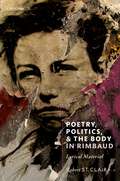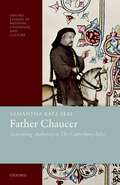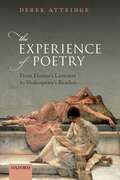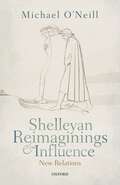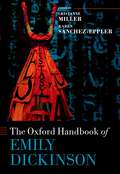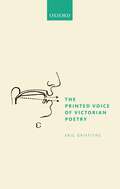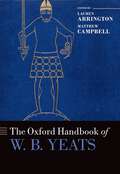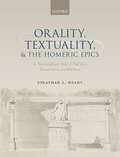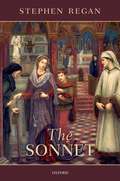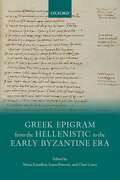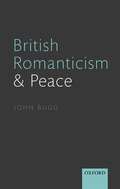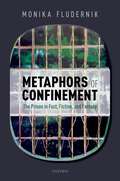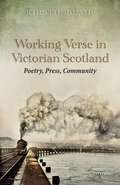- Table View
- List View
Poetry, Politics, and the Body in Rimbaud: Lyrical Material
by Robert St. ClairBodies abound in Rimbaud's poetry in a way that is nearly unprecedented in the nineteenth-century poetic canon: lazy, creative, rule-breaking bodies, queer bodies, marginalized and impoverished bodies, revolting and revolutionary, historical bodies. The question that Poetry, Politics, and the Body seeks to answer is: What does this corporeal density mean for reading Rimbaud? What kind of sense are we to make of this omnipresence of the body in the Rimbaldian corpus, from first to last–from the earliest poems in verse celebrating the sheer, simple delight of running away from wherever one is and stretching one's legs out under a table, to the ultimate flight away from poetry itself? In response, this book argues that the body appears–often literally–as a kind of gap, breach, or aperture through which Rimbaud's poems enter into contact with history and a larger body of other texts. Simply put, the body is privileged 'lyrical material' for Rimbaud: a figure for human beings in their exposed, finite creatureliness and in their unpredictable agency and interconnectedness. Its presence in the early work allows us not only to contemplate what a strange, sensuous thing it is to be embodied, to be both singular and part of a collective, it also allows the poet to diagnose, and the reader to perceive, a set of seemingly intractable, 'real' socio-economic, political, and symbolic problems. Rimbaud's bodies are, in other words, utopian bodies: sites where the historical and the lyrical, the ideal and the material, do not so much cancel each other out as become caught up in one another.
Poetry, Politics, and the Body in Rimbaud: Lyrical Material
by Robert St. ClairBodies abound in Rimbaud's poetry in a way that is nearly unprecedented in the nineteenth-century poetic canon: lazy, creative, rule-breaking bodies, queer bodies, marginalized and impoverished bodies, revolting and revolutionary, historical bodies. The question that Poetry, Politics, and the Body seeks to answer is: What does this corporeal density mean for reading Rimbaud? What kind of sense are we to make of this omnipresence of the body in the Rimbaldian corpus, from first to last–from the earliest poems in verse celebrating the sheer, simple delight of running away from wherever one is and stretching one's legs out under a table, to the ultimate flight away from poetry itself? In response, this book argues that the body appears–often literally–as a kind of gap, breach, or aperture through which Rimbaud's poems enter into contact with history and a larger body of other texts. Simply put, the body is privileged 'lyrical material' for Rimbaud: a figure for human beings in their exposed, finite creatureliness and in their unpredictable agency and interconnectedness. Its presence in the early work allows us not only to contemplate what a strange, sensuous thing it is to be embodied, to be both singular and part of a collective, it also allows the poet to diagnose, and the reader to perceive, a set of seemingly intractable, 'real' socio-economic, political, and symbolic problems. Rimbaud's bodies are, in other words, utopian bodies: sites where the historical and the lyrical, the ideal and the material, do not so much cancel each other out as become caught up in one another.
Father Chaucer: Generating Authority in The Canterbury Tales (Oxford Studies in Medieval Literature and Culture)
by Samantha Katz SealThe monograph series Oxford Studies in Medieval Literature and Culture showcases the plurilingual and multicultural quality of medieval literature and actively seeks to promote research that not only focuses on the array of subjects medievalists now pursue in literature, theology, and philosophy, in social, political, jurisprudential, and intellectual history, the history of art, and the history of science but also that combines these subjects productively. It offers innovative studies on topics that may include, but are not limited to, manuscript and book history; languages and literatures of the global Middle Ages; race and the post-colonial; the digital humanities, media and performance; music; medicine; the history of affect and the emotions; the literature and practices of devotion; the theory and history of gender and sexuality, ecocriticism and the environment; theories of aesthetics; medievalism. When Geoffrey Chaucer is named the 'Father of English poetry', an inherent assumption about paternity is transmitted. Chaucer's 'fatherhood' is presented as a means of poetic legitimization, a stable mode of authority that connects the medieval author with all the successive generations of English writers. This book argues, however, that for Chaucer himself, paternity was a far more fraught ambition, one capable of devastating male identity as surely as it could enshrine it. Moving away from anachronistic assumptions about reproduction and authority, this book argues that Chaucer profoundly struggled with his own desire to create something that would last past his own death. For Chaucer also believed that men were the humble, mortal playthings of an all too distant God. Medieval Christianity taught that the earth was but a temporary, sorrowful abode for corrupted men, and that the fall from grace was reborn within each generation of Adam's sons. Chaucer knew that God had set sharp limits upon man's ability to create with certainty, and to determine his own posterity. Yet, what could be more human than the longing to wrest some small authority from one's own mortal flesh? This book argues that this essential intellectual, ethical, and religious crisis lies at the very heart of Chaucer's Canterbury Tales. Within this masterpiece of English literature, Chaucer boldly confronts the impossibility of his own aching wish to see his offspring, biological and poetic, last beyond his own death, to claim the authority simultaneously promised and denied by the very act of creation.
Father Chaucer: Generating Authority in The Canterbury Tales (Oxford Studies in Medieval Literature and Culture)
by Samantha Katz SealThe monograph series Oxford Studies in Medieval Literature and Culture showcases the plurilingual and multicultural quality of medieval literature and actively seeks to promote research that not only focuses on the array of subjects medievalists now pursue in literature, theology, and philosophy, in social, political, jurisprudential, and intellectual history, the history of art, and the history of science but also that combines these subjects productively. It offers innovative studies on topics that may include, but are not limited to, manuscript and book history; languages and literatures of the global Middle Ages; race and the post-colonial; the digital humanities, media and performance; music; medicine; the history of affect and the emotions; the literature and practices of devotion; the theory and history of gender and sexuality, ecocriticism and the environment; theories of aesthetics; medievalism. When Geoffrey Chaucer is named the 'Father of English poetry', an inherent assumption about paternity is transmitted. Chaucer's 'fatherhood' is presented as a means of poetic legitimization, a stable mode of authority that connects the medieval author with all the successive generations of English writers. This book argues, however, that for Chaucer himself, paternity was a far more fraught ambition, one capable of devastating male identity as surely as it could enshrine it. Moving away from anachronistic assumptions about reproduction and authority, this book argues that Chaucer profoundly struggled with his own desire to create something that would last past his own death. For Chaucer also believed that men were the humble, mortal playthings of an all too distant God. Medieval Christianity taught that the earth was but a temporary, sorrowful abode for corrupted men, and that the fall from grace was reborn within each generation of Adam's sons. Chaucer knew that God had set sharp limits upon man's ability to create with certainty, and to determine his own posterity. Yet, what could be more human than the longing to wrest some small authority from one's own mortal flesh? This book argues that this essential intellectual, ethical, and religious crisis lies at the very heart of Chaucer's Canterbury Tales. Within this masterpiece of English literature, Chaucer boldly confronts the impossibility of his own aching wish to see his offspring, biological and poetic, last beyond his own death, to claim the authority simultaneously promised and denied by the very act of creation.
The Experience of Poetry: From Homer's Listeners to Shakespeare's Readers
by Derek AttridgeWas the experience of poetry—or a cultural practice we now call poetry—continuously available across the two-and-a-half millennia from the composition of the Homeric epics to the publication of Ben Jonson's Works and the death of Shakespeare in 1616? How did the pleasure afforded by the crafting of language into memorable and moving rhythmic forms play a part in the lives of hearers and readers in Ancient Greece and Rome, Europe during Late Antiquity and the Middle Ages, and Britain during the Renaissance? In tackling these questions, this book first examines the evidence for the performance of the Iliad and the Odyssey and of Ancient Greek lyric poetry, the impact of the invention of writing on Alexandrian verse, the performances of poetry that characterized Ancient Rome, and the private and public venues for poetic experience in Late Antiquity. It moves on to deal with medieval verse, exploring the oral traditions that spread across Europe in the vernacular languages, the place of manuscript transmission, the shift from roll to codex and from papyrus to parchment, and the changing audiences for poetry. A final part investigates the experience of poetry in the English Renaissance, from the manuscript verse of Henry VIII's court to the anthologies and collections of the late Elizabethan era. Among the topics considered in this part are the importance of the printed page, the continuing significance of manuscript circulation, the performance of poetry in pageants and progresses, and the appearance of poets on the Elizabethan stage. In tracking both continuity and change across these many centuries, the book throws fresh light on the role and importance of poetry in western culture.
The Experience of Poetry: From Homer's Listeners to Shakespeare's Readers
by Derek AttridgeWas the experience of poetry—or a cultural practice we now call poetry—continuously available across the two-and-a-half millennia from the composition of the Homeric epics to the publication of Ben Jonson's Works and the death of Shakespeare in 1616? How did the pleasure afforded by the crafting of language into memorable and moving rhythmic forms play a part in the lives of hearers and readers in Ancient Greece and Rome, Europe during Late Antiquity and the Middle Ages, and Britain during the Renaissance? In tackling these questions, this book first examines the evidence for the performance of the Iliad and the Odyssey and of Ancient Greek lyric poetry, the impact of the invention of writing on Alexandrian verse, the performances of poetry that characterized Ancient Rome, and the private and public venues for poetic experience in Late Antiquity. It moves on to deal with medieval verse, exploring the oral traditions that spread across Europe in the vernacular languages, the place of manuscript transmission, the shift from roll to codex and from papyrus to parchment, and the changing audiences for poetry. A final part investigates the experience of poetry in the English Renaissance, from the manuscript verse of Henry VIII's court to the anthologies and collections of the late Elizabethan era. Among the topics considered in this part are the importance of the printed page, the continuing significance of manuscript circulation, the performance of poetry in pageants and progresses, and the appearance of poets on the Elizabethan stage. In tracking both continuity and change across these many centuries, the book throws fresh light on the role and importance of poetry in western culture.
Shelleyan Reimaginings and Influence: New Relations
by Michael O'NeillThrough attuned close readings, this volume brings out the imaginative and formal brilliance of Percy Bysshe Shelley's writing as it explores his involvement in processes of dialogue and influence. Shelley recognizes that poetic individuality is the reward of connectedness with other writers and cultural influences. 'A great Poem is a fountain forever overflowing with the waters of wisdom and delight', he writes, 'and after one person and one age has exhausted all its divine effluence which their peculiar relations enable them to share, another and yet another succeeds, and new relations are ever developed, the source of an unforeseen and an unconceived delight' (A Defence of Poetry). He is among the major Romantic poetic exponents and theorists of influence, because of his passionately intelligent commitment to the onward dissemination of ideas and feelings, and to the unpredictable ways in which poets position themselves and are culturally positioned between past and future. The book has a tripartite structure. The first three chapters seek to illuminate his response to representative texts, figures, and themes that constitute the triple pillars of his cultural inheritance: the classical world (Plato); Renaissance poetry (Spenser and Milton); Christianity and, in particular, the concept of deity and the Bible. The second and major section of the book explores Shelley's relations and affinities with, as well as differences from, his immediate predecessors and contemporaries: Hazlitt and Lamb; Wordsworth; Coleridge; Southey; Byron; Keats (including the influence of Dante on Shelley's elegy for his fellow Romantic) and the great painter J. M. W. Turner, with whom he is often linked. The third section considers Shelley's reception by later nineteenth-century writers, figures influenced by and responding to Shelley including Beddoes, Hemans, Landon, Tennyson, and Swinburne. A coda discusses the body of critical work on Shelley produced by A. C. Bradley, a figure who stands at the threshold of twentieth-century thinking about Shelley.
Shelleyan Reimaginings and Influence: New Relations
by Michael O'NeillThrough attuned close readings, this volume brings out the imaginative and formal brilliance of Percy Bysshe Shelley's writing as it explores his involvement in processes of dialogue and influence. Shelley recognizes that poetic individuality is the reward of connectedness with other writers and cultural influences. 'A great Poem is a fountain forever overflowing with the waters of wisdom and delight', he writes, 'and after one person and one age has exhausted all its divine effluence which their peculiar relations enable them to share, another and yet another succeeds, and new relations are ever developed, the source of an unforeseen and an unconceived delight' (A Defence of Poetry). He is among the major Romantic poetic exponents and theorists of influence, because of his passionately intelligent commitment to the onward dissemination of ideas and feelings, and to the unpredictable ways in which poets position themselves and are culturally positioned between past and future. The book has a tripartite structure. The first three chapters seek to illuminate his response to representative texts, figures, and themes that constitute the triple pillars of his cultural inheritance: the classical world (Plato); Renaissance poetry (Spenser and Milton); Christianity and, in particular, the concept of deity and the Bible. The second and major section of the book explores Shelley's relations and affinities with, as well as differences from, his immediate predecessors and contemporaries: Hazlitt and Lamb; Wordsworth; Coleridge; Southey; Byron; Keats (including the influence of Dante on Shelley's elegy for his fellow Romantic) and the great painter J. M. W. Turner, with whom he is often linked. The third section considers Shelley's reception by later nineteenth-century writers, figures influenced by and responding to Shelley including Beddoes, Hemans, Landon, Tennyson, and Swinburne. A coda discusses the body of critical work on Shelley produced by A. C. Bradley, a figure who stands at the threshold of twentieth-century thinking about Shelley.
The Oxford Handbook of Emily Dickinson (Oxford Handbooks)
The Oxford Handbook of Emily Dickinson is designed to engage, inform, interest, and delight students and scholars of Emily Dickinson, of nineteenth-century US literature and cultural studies, of American poetry, and of the lyric. It also establishes potential agendas for future work in the field of Dickinson studies. This is the first collection on Dickinson to foreground the material and social culture of her time while opening new windows to interpretive possibility in ours. The volume strives to balance Dickinson's own center of gravity in the material culture and historical context of nineteenth-century Amherst with the significance of important critical conversations of our present, thus understanding her poetry with the broadest "Latitude of Home"—as she puts it in her poem "Forever-is composed of Nows." Debates about the lyric, about Dickinson's manuscripts and practices of composition, about the viability of translation across language, media, and culture, and about the politics of class, gender, place, and race circulate through this volume. These debates matter to our moment but also to our understanding of hers. Although rooted in the evolving history of Dickinson criticism, the chapters foreground truly new original research and a wide range of innovative critical methodologies, including artistic responses to her poetry by musicians, visual artists, and other poets. The suppleness and daring of Dickinson's thought and uses of language remain open to new possibilities and meanings, even while they are grounded in contexts from over 150 years ago, and this collection expresses and celebrates the breadth of her accomplishments and relevance.
The Oxford Handbook of Emily Dickinson (Oxford Handbooks)
by Cristanne Miller, Karen Sánchez-epplerThe Oxford Handbook of Emily Dickinson is designed to engage, inform, interest, and delight students and scholars of Emily Dickinson, of nineteenth-century US literature and cultural studies, of American poetry, and of the lyric. It also establishes potential agendas for future work in the field of Dickinson studies. This is the first collection on Dickinson to foreground the material and social culture of her time while opening new windows to interpretive possibility in ours. The volume strives to balance Dickinson's own center of gravity in the material culture and historical context of nineteenth-century Amherst with the significance of important critical conversations of our present, thus understanding her poetry with the broadest "Latitude of Home"—as she puts it in her poem "Forever-is composed of Nows." Debates about the lyric, about Dickinson's manuscripts and practices of composition, about the viability of translation across language, media, and culture, and about the politics of class, gender, place, and race circulate through this volume. These debates matter to our moment but also to our understanding of hers. Although rooted in the evolving history of Dickinson criticism, the chapters foreground truly new original research and a wide range of innovative critical methodologies, including artistic responses to her poetry by musicians, visual artists, and other poets. The suppleness and daring of Dickinson's thought and uses of language remain open to new possibilities and meanings, even while they are grounded in contexts from over 150 years ago, and this collection expresses and celebrates the breadth of her accomplishments and relevance.
The Printed Voice of Victorian Poetry
by Eric GriffithsThe Printed Voice of Victorian Poetry starts from a simple fact: our written language does not represent the way we speak. Intonation, accent, tempo, and pitch of utterance can be inferred from a written text but they are not clearly demonstrated there. The book shows the implications of this fact for linguists and philosophers of language and offers fundamental criticisms of some recent work in these fields. It aims principally to describe the ways in which nineteenth-century English poets–Tennyson, Browning, Hopkins–responded creatively to the ambiguities involved in writing down their own voices, the melodies of their speech. Original readings of the poets' work are given, both at a minutely detailed level and with regard to major preoccupations of the period–immortality, morbidity, marriage, social divisions, and religious conversions–and in this way Eric Griffiths offers a new map of Victorian poetry.
The Printed Voice of Victorian Poetry
by Eric GriffithsThe Printed Voice of Victorian Poetry starts from a simple fact: our written language does not represent the way we speak. Intonation, accent, tempo, and pitch of utterance can be inferred from a written text but they are not clearly demonstrated there. The book shows the implications of this fact for linguists and philosophers of language and offers fundamental criticisms of some recent work in these fields. It aims principally to describe the ways in which nineteenth-century English poets–Tennyson, Browning, Hopkins–responded creatively to the ambiguities involved in writing down their own voices, the melodies of their speech. Original readings of the poets' work are given, both at a minutely detailed level and with regard to major preoccupations of the period–immortality, morbidity, marriage, social divisions, and religious conversions–and in this way Eric Griffiths offers a new map of Victorian poetry.
The Oxford Handbook of W.B. Yeats (Oxford Handbooks)
The forty-two chapters in this book consider Yeats's early toil, his practical and esoteric concerns as his career developed, his friends and enemies, and how he was and is understood. This Handbook brings together critics and writers who have considered what Yeats wrote and how he wrote, moving between texts and their contexts in ways that will lead the reader through Yeats's multiple selves as poet, playwright, public figure, and mystic. It assembles a variety of views and adds to a sense of dialogue, the antinomian or deliberately-divided way of thinking that Yeats relished and encouraged. This volume puts that sense of a living dialogue in tune both with the history of criticism on Yeats and also with contemporary critical and ethical debates, not shirking the complexities of Yeats's more uncomfortable political positions or personal life. It provides one basis from which future Yeats scholarship can continue to participate in the fascination of all the contributors here in the satisfying difficulty of this great writer.
The Oxford Handbook of W.B. Yeats (Oxford Handbooks)
by Lauren Arrington and Matthew CampbellThe forty-two chapters in this book consider Yeats's early toil, his practical and esoteric concerns as his career developed, his friends and enemies, and how he was and is understood. This Handbook brings together critics and writers who have considered what Yeats wrote and how he wrote, moving between texts and their contexts in ways that will lead the reader through Yeats's multiple selves as poet, playwright, public figure, and mystic. It assembles a variety of views and adds to a sense of dialogue, the antinomian or deliberately-divided way of thinking that Yeats relished and encouraged. This volume puts that sense of a living dialogue in tune both with the history of criticism on Yeats and also with contemporary critical and ethical debates, not shirking the complexities of Yeats's more uncomfortable political positions or personal life. It provides one basis from which future Yeats scholarship can continue to participate in the fascination of all the contributors here in the satisfying difficulty of this great writer.
Orality, Textuality, and the Homeric Epics: An Interdisciplinary Study of Oral Texts, Dictated Texts, and Wild Texts
by Jonathan L. ReadyWritten texts of the Iliad and the Odyssey achieved an unprecedented degree of standardization after 150 BCE, but what about Homeric texts prior to the emergence of standardized written texts? Orality, Textuality, and the Homeric Epics sheds light on that earlier history by drawing on scholarship from outside the discipline of classical studies to query from three different angles what it means to speak of Homeric poetry together with the word "text". Part I utilizes work in linguistic anthropology on oral texts and oral intertextuality to illuminate both the verbal and oratorical landscapes our Homeric poets fashion in their epics and what the poets were striving to do when they performed. Looking to folkloristics, part II examines modern instances of the textualization of an oral traditional work in order to reconstruct the creation of written versions of the Homeric poems through a process that began with a poet dictating to a scribe. Combining research into scribal activity in other cultures, especially in the fields of religious studies and medieval studies, with research into performance in the field of linguistic anthropology, part III investigates some of the earliest extant texts of the Homeric epics, the so-called wild papyri. By looking at oral texts, dictated texts, and wild texts, this volume traces the intricate history of Homeric texts from the Archaic to the Hellenistic period, long before the emergence of standardized written texts, in a comparative and interdisciplinary study that will benefit researchers in a number of disciplines across the humanities.
Orality, Textuality, and the Homeric Epics: An Interdisciplinary Study of Oral Texts, Dictated Texts, and Wild Texts
by Jonathan L. ReadyWritten texts of the Iliad and the Odyssey achieved an unprecedented degree of standardization after 150 BCE, but what about Homeric texts prior to the emergence of standardized written texts? Orality, Textuality, and the Homeric Epics sheds light on that earlier history by drawing on scholarship from outside the discipline of classical studies to query from three different angles what it means to speak of Homeric poetry together with the word "text". Part I utilizes work in linguistic anthropology on oral texts and oral intertextuality to illuminate both the verbal and oratorical landscapes our Homeric poets fashion in their epics and what the poets were striving to do when they performed. Looking to folkloristics, part II examines modern instances of the textualization of an oral traditional work in order to reconstruct the creation of written versions of the Homeric poems through a process that began with a poet dictating to a scribe. Combining research into scribal activity in other cultures, especially in the fields of religious studies and medieval studies, with research into performance in the field of linguistic anthropology, part III investigates some of the earliest extant texts of the Homeric epics, the so-called wild papyri. By looking at oral texts, dictated texts, and wild texts, this volume traces the intricate history of Homeric texts from the Archaic to the Hellenistic period, long before the emergence of standardized written texts, in a comparative and interdisciplinary study that will benefit researchers in a number of disciplines across the humanities.
The Sonnet
by Stephen ReganThe Sonnet provides a comprehensive study of one of the oldest and most popular forms of poetry, widely used by Shakespeare, Milton, and Wordsworth, and still used centuries later by poets such as Seamus Heaney, Tony Harrison, and Carol Ann Duffy. This book traces the development of the sonnet from its origins in medieval Italy to its widespread acceptance in modern Britain, Ireland, and America. It shows how the sonnet emerges from the aristocratic courtly centres of Renaissance Europe and gradually becomes the chosen form of radical political poets such as Milton. The book draws on detailed critical analysis of some of the best-known sonnets written in English to explain how the sonnet functions as a poetic form, and it argues that the flexibility and versatility of the sonnet have given it a special place in literary history and tradition.
Greek Epigram from the Hellenistic to the Early Byzantine Era
Greek epigram is a remarkable poetic form. The briefest of all ancient Greek genres, it is also the most resilient: for almost a thousand years it attracted some of the finest Greek poetic talents as well as exerting a profound influence on Latin literature, and it continues to inspire and influence modern translations and imitations. After a long period of neglect, research on epigram has surged during recent decades, and this volume draws on the fruits of that renewed scholarly engagement. It is concerned not with the work of individual authors or anthologies, but with the complexities of epigram as a genre, and provides a selection of in-depth treatments of key aspects of Greek literary epigram of the Hellenistic, Roman, and early Byzantine periods. Individual chapters offer insights into a variety of topics, from the dynamic interactions between poets and their predecessors and contemporaries, and the relationship between epigram and its sociopolitical, cultural, and literary background from the third century BCE up until the sixth century CE, to its interaction with its origins, inscribed epigram more generally, other literary genres, the visual arts, and Latin poetry, as well as the process of editing and compilation that generated the collections that survived into the modern world. Through the medium of individual studies the volume as a whole seeks to offer a sense of this vibrant and dynamic poetic form and its world, which will be of value to scholars and students of Greek epigram and classical literature more broadly.
Greek Epigram from the Hellenistic to the Early Byzantine Era
by Chris Carey Ivana Petrovic Maria KanellouGreek epigram is a remarkable poetic form. The briefest of all ancient Greek genres, it is also the most resilient: for almost a thousand years it attracted some of the finest Greek poetic talents as well as exerting a profound influence on Latin literature, and it continues to inspire and influence modern translations and imitations. After a long period of neglect, research on epigram has surged during recent decades, and this volume draws on the fruits of that renewed scholarly engagement. It is concerned not with the work of individual authors or anthologies, but with the complexities of epigram as a genre, and provides a selection of in-depth treatments of key aspects of Greek literary epigram of the Hellenistic, Roman, and early Byzantine periods. Individual chapters offer insights into a variety of topics, from the dynamic interactions between poets and their predecessors and contemporaries, and the relationship between epigram and its sociopolitical, cultural, and literary background from the third century BCE up until the sixth century CE, to its interaction with its origins, inscribed epigram more generally, other literary genres, the visual arts, and Latin poetry, as well as the process of editing and compilation that generated the collections that survived into the modern world. Through the medium of individual studies the volume as a whole seeks to offer a sense of this vibrant and dynamic poetic form and its world, which will be of value to scholars and students of Greek epigram and classical literature more broadly.
British Romanticism and Peace
by John BuggThis is the first book to bring perspectives from the interdisciplinary field of Peace Studies to bear on the writing of the Romantic period. Particularly significant is that field's attention not only to the work of anti-war protest, but more purposefully to considerations of how peace can actively be fostered, established, and sustained. Bravely resisting discourses of military propaganda, writers such as Amelia Opie, Helen Maria Williams, William Wordsworth, William Cobbett, John Keats, and Jane Austen embarked on the challenging and urgent rhetorical work of imagining—and inspiring others to imagine—the possibility of peace. The writers formulate a peace imaginary in various registers. Sometimes this means identifying and eschewing traditional militaristic tropes in order to craft alternative images for a patriotism compatible with peace. Other times it means turning away from xenophobic discourse to write about relations with other nations in terms other than those of conflict. If historically informed literary criticism has illustrated the importance of writing about war during the Romantic period, this volume invites readers to redirect critical attention to move beyond discourses of war, and to recognize the era's complex and vibrant writing about and for peace.
British Romanticism and Peace
by John BuggThis is the first book to bring perspectives from the interdisciplinary field of Peace Studies to bear on the writing of the Romantic period. Particularly significant is that field's attention not only to the work of anti-war protest, but more purposefully to considerations of how peace can actively be fostered, established, and sustained. Bravely resisting discourses of military propaganda, writers such as Amelia Opie, Helen Maria Williams, William Wordsworth, William Cobbett, John Keats, and Jane Austen embarked on the challenging and urgent rhetorical work of imagining—and inspiring others to imagine—the possibility of peace. The writers formulate a peace imaginary in various registers. Sometimes this means identifying and eschewing traditional militaristic tropes in order to craft alternative images for a patriotism compatible with peace. Other times it means turning away from xenophobic discourse to write about relations with other nations in terms other than those of conflict. If historically informed literary criticism has illustrated the importance of writing about war during the Romantic period, this volume invites readers to redirect critical attention to move beyond discourses of war, and to recognize the era's complex and vibrant writing about and for peace.
Metaphors of Confinement: The Prison in Fact, Fiction, and Fantasy (Law and Literature)
by Monika FludernikMetaphors of Confinement: The Prison in Fact, Fiction, and Fantasy offers a historical survey of imaginings of the prison as expressed in carceral metaphors in a range of texts about imprisonment from Antiquity to the present as well as non-penal situations described as confining or restrictive. These imaginings coalesce into a 'carceral imaginary' that determines the way we think about prisons, just as social debates about punishment and criminals feed into the way carceral imaginary develops over time. Examining not only English-language prose fiction but also poetry and drama from the Middle Ages to postcolonial, particularly African, literature, the book juxtaposes literary and non-literary contexts and contrasts fictional and nonfictional representations of (im)prison(ment) and discussions about the prison as institution and experiential reality. It comments on present-day trends of punitivity and foregrounds the ethical dimensions of penal punishment. The main argument concerns the continuity of carceral metaphors through the centuries despite historical developments that included major shifts in policy (such as the invention of the penitentiary). The study looks at selected carceral metaphors, often from two complementary perspectives, such as the home as prison or the prison as home, or the factory as prison and the prison as factory. The case studies present particularly relevant genres and texts that employ these metaphors, often from a historical perspective that analyses development through different periods.
Metaphors of Confinement: The Prison in Fact, Fiction, and Fantasy (Law and Literature)
by Monika FludernikMetaphors of Confinement: The Prison in Fact, Fiction, and Fantasy offers a historical survey of imaginings of the prison as expressed in carceral metaphors in a range of texts about imprisonment from Antiquity to the present as well as non-penal situations described as confining or restrictive. These imaginings coalesce into a 'carceral imaginary' that determines the way we think about prisons, just as social debates about punishment and criminals feed into the way carceral imaginary develops over time. Examining not only English-language prose fiction but also poetry and drama from the Middle Ages to postcolonial, particularly African, literature, the book juxtaposes literary and non-literary contexts and contrasts fictional and nonfictional representations of (im)prison(ment) and discussions about the prison as institution and experiential reality. It comments on present-day trends of punitivity and foregrounds the ethical dimensions of penal punishment. The main argument concerns the continuity of carceral metaphors through the centuries despite historical developments that included major shifts in policy (such as the invention of the penitentiary). The study looks at selected carceral metaphors, often from two complementary perspectives, such as the home as prison or the prison as home, or the factory as prison and the prison as factory. The case studies present particularly relevant genres and texts that employ these metaphors, often from a historical perspective that analyses development through different periods.
Working Verse in Victorian Scotland: Poetry, Press, Community
by Kirstie BlairThis volume reassesses working-class poetry and poetics in Victorian Britain, using Scotland as a focus and with particular attention to the role of the popular press in fostering and disseminating working-class verse cultures. It studies a very wide variety of writers who are unknown to scholarship, and assesses the political, social, and cultural work which their poetry performed. During the Victorian period, Scotland underwent unprecedented changes in terms of industrialization, the rise of the city, migration, and emigration. This study shows how poets who defined themselves as part of a specifically Scottish tradition responded to these changes. It substantially revises our understanding of Scottish literature in this period, while contributing to wider investigations of the role of popular verse in national and international cultures.
Working Verse in Victorian Scotland: Poetry, Press, Community
by Kirstie BlairThis volume reassesses working-class poetry and poetics in Victorian Britain, using Scotland as a focus and with particular attention to the role of the popular press in fostering and disseminating working-class verse cultures. It studies a very wide variety of writers who are unknown to scholarship, and assesses the political, social, and cultural work which their poetry performed. During the Victorian period, Scotland underwent unprecedented changes in terms of industrialization, the rise of the city, migration, and emigration. This study shows how poets who defined themselves as part of a specifically Scottish tradition responded to these changes. It substantially revises our understanding of Scottish literature in this period, while contributing to wider investigations of the role of popular verse in national and international cultures.
